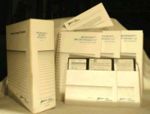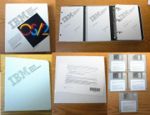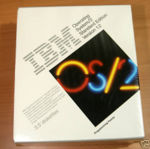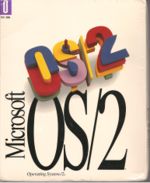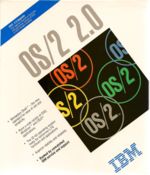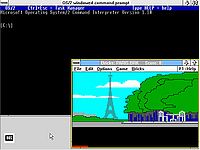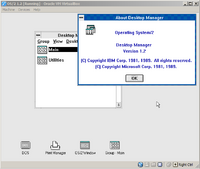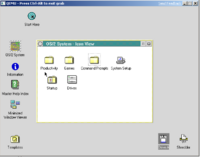Difference between revisions of "OS/2"
(→Versions) |
(→Running OS/2 under an Emulator) |
||
| Line 133: | Line 133: | ||
OS/2 1.1c is the first version that supports the 386's method of switching from [[protected mode]] to [[real mode]]. Prior to level c of OS/2 1.1 the method was a 286 [[tripple fault]], which almost all emulators do not fully support. | OS/2 1.1c is the first version that supports the 386's method of switching from [[protected mode]] to [[real mode]]. Prior to level c of OS/2 1.1 the method was a 286 [[tripple fault]], which almost all emulators do not fully support. | ||
| + | |||
| + | ==== OS/2 1.2 ==== | ||
| + | [[Image:OS2 1.2.png|thumb|200px|right|OS/2 1.2 on VirtualBOX]] | ||
| + | With the above hex edits in place, OS/2 1.2 installs somewhat ok. The big 'issue' I found was that the IBM version of OS/2 1.2 does not support PS/2 mice on the IBM AT computers. However you can take the PS/2 driver from OS/2 1.3 and use it. | ||
==== OS/2 1.3 ==== | ==== OS/2 1.3 ==== | ||
Revision as of 05:13, 31 May 2011
OS/2 started as a collabrative effort between IBM and Microsoft to put together the next generation Operating System for the IBM AT and PS/2 machines.
Microsoft, famous for hedging bets, started the Windows project around the same time, as a low cost entry interface with rudementary (cooperative) multitasking
Needless to say Microsoft wanted to target the i386 processor, and work on 32bit software, while IBM wanted to deliver to the IBM AT customers it had sold to, and demanded the i286 16bit version. Someone at IBM even got the idea that the development tools should be a revenue stream, and needless to say, the $3,000 SDK was *NOT* a big seller. Instead the industry worked around OS/2, and developed DOS Extenders technology, and Microsoft practically gave away the Windows SDK, allowed for OEM customizations, and famously released the QuickC for Windows product.
Microsoft lept at the chance to formalize DOS extenders into DPMI, and use it in Windows, cementing OS/2's 1.x inability to run DPMI programs. Microsoft was also upset that IBM locked them out of the graphical components of the OS, and that OS/2 worked BACKWARDS compared to Windows... the 0/0 in the screen coordinates is the bottom right, while everywhere else it's the top left..
There is a great writeup on the divorce on google's usenet archive:
http://groups.google.com/group/comp.os.ms-windows.misc/msg/d710490b745d5e5e Or locally here Gordon Letwin OS/2 usenet post.
Versions
16 bit versions
All of these versions require an i286 cpu, and an IBM AT, or PS/2 compatible computer.
- 1.0
This version was all textmode, and had an interface that was inspired from TopView. Although it could multitask, most people didn't realize it, as all programs ran full screen. It ran in 286 protected mode, except for the single "DOS" mode session. As a result all device drivers for OS/2 had to be able to run in real & protected mode. Until 1.3 all versions were released by OEM hardware vendors (Compaq, Zenith etc, along with IBM), this was normal practice for Microsoft at the time.
- 1.1
This version introduced Presentation Manager. It 'looked' identical to that of Windows 2.0. Version 1.1c was 386 aware, in that it could use the 80386's ability to quickly & easily transition from real & protected modes, bypassing the triple fault method of the 286.
- 1.2
I think this version was released in September of 1988. This release was significant with the inclusion of the HPFS filesystem. HPFS was significantly faster then the aging FAT filesystem as it placed its tables in the middle of the disk, and it allowed for larger filesystems, long filenames and extended attributes. A later service pack allowed for 386 and above CPUs to use the 386 method of switching between real & protected mode, allowing it to operate significantly faster (1.2c). From what I understand this was the last version of OS/2 that included direct involvement from Microsoft.
OS/2 1.2 from IBM included the 'standard' edition, along with the EE or extended edition. The EE edition included basic communications capability (x.25, rs232 terminal), and a SQL database.
InfoWorld included an excellent review of OS/2 1.2 here.
- 1.3
This was the last version of the 16 bit OS/2 family. The 1.3 user interface resembled that of Windows 3.0. Microsoft did include a 32bit HPFS driver in their Lan Manager package which allowed for the fastest HPFS implementation prior to OS/2 2.0 & Windows NT 3.1
Around this time, Microsoft had released a beta of the WLO or Windows library for OS/2. The beta included a copy of all of the applettes & games from Windows 3.0 that could run in the Presentation Manager of OS/2. These libraries were also used to deliver the last versions of Microsoft Word & Excel for OS/2. Microsoft had planned on releasing these libraries to allow people to easily port their Windows applications to OS/2, but the rift had happened right before that date, so the beta (which is easy to find) was the only thing released. You can read more about it here.
Additionally, market penetration and OEM interest in OS/2 had dwindled so quickly by this point that Microsoft had decided to do a retail version of OS/2 (pictured to the right) to support its new Microsoft SQL Server product. Windows NT on the i386 platform included support for 16bit OS/2 applications, namely for the Microsoft Languages (Fortran/Assembler & C) and SQL Server. Since they all were text mode, they would run unmodified up through Windows 2000.
32bit versions
All of these versions require an i386 SX or better CPU running on either an IBM AT compatible motherboard, or the IBM PS/2 32bit machines.
OS/2 2.x
- 2.0 LA (10/1991)
This was the first 32bit version. It was released after the IBM/Microsoft divorce, and was strictly an IBM release. There was no seamless Windows in this release, and Win-OS/2 only featured Windows 3.0a in standard mode.
- 2.0 GA (04/1992)
This release included Windows 3.0 for use in Win OS/2. At the time of the release the Presentation Managers graphic drivers were still 16 bit, although a later service pack was released which included 32bit drivers. It's interesting to note that OS/2's market share was so low at this time, that OS/2 2.0 included the ability to load older 16bit device drivers as the kernel was still a hybrid 16bit/32bit kernel.
The GUI had radically changed from 1.3 to 2.0 as it now included the Workplace Shell, a full OO GUI. Many people considered WPS to be 'the' killer application at the time, as Windows still had the program manager.
The new Presentation Manager replacement, Workplace Shell, included a deal with Commodore for the "look and feel" of AmigaDOS, and as part of the deal, Commodore picked up a license for REXX into its products as first seen by AmigaDOS 2.0 .
The default syslevel for OS/2 2.0 is XR02000. The last known service pack for OS/2 2.0 brings it up to XR06100. The XR06100 update also installs the OS/2 32-bit Graphics Engine, XR02010.
- 2.1 (06/1993)
This release brought the Win OS/2 functionality up to Windows 3.1. From the user standpoint it still looked like 2.0 . OS/2 2.1 also included the multimedia update which would allow for sound effects for almost every conceivable motion. It was very annoying.
OS/2 2.1 also supported more video cards, more printers, and included support for PCMCIA and APM, making it acceptable for laptop use.
The update XR06200 brings OS/2 2.1 up to 2.11 functionality.
- 2.11 (02/1994)
- 2.11 SMP (08/1994)
OS/2 2.11 supported multiple processors, and from a user standpoint it was halfway between 2.11 and Warp. I remember this version being insanely expensive, as it was targeted to the 'server' crowd, IBM had shortsightedly decided end users wouldn't want SMP. While Windows NT Workstation always supported two physical processors.
OS/2 Warp 3
- 3.0 (09/1994)
This was the WARP release. At the time this release preempted the Windows 95 release. IBM had done their best to tune OS/2 to run in 4MB of ram on a 386sx cpu. Warp also included the 'bonus pack' which included SLIP/PPP TCP/IP, a dialer application and a word processor & spreadsheet. A simple gopher client & NNTP client were also included.
IMHO this is where IBM missed the boat, by making TCP/IP difficult to configure, and by not including LAN drivers (that was WARP CONNECT), while Windows 95 & NT 3.5 both included SLIP/PPP *AND* lan drivers.
I *THINK* it was this release that included the ability to run Win32s, which was a boon for Netscape & Mosaic.
- 3.01 (1995)
OS/2 Warp with Win-OS/2
- 3.02 (1995)
OS/2 Warp Connect OS/2 Warp Server OS/2 Warp Server Advanced
- 3.05 (01/1996)
OS/2 Warp Server Advanced for SMP
OS/2 Warp 4
- 4.0
OS/2 4.0 included both Java and Netscape in this release. Sadly IBM had still not 'gotten it' with regards to TCP/IP and insisted on a 'connect' version of 4.0 that included the LAN drivers. 4.0 also included the ability to install servicepacks online.
- 4.01
Workspace on-Demand 1.0 (WSOD) Workspace on-Demand 2.0
- 4.5
IBM OS/2 Warp Server for e-business Fixpak >=13 applied to OS/2 Warp 4 or WSOD
- 4.51
Aurora Convenience Package 1 (ACP1), Merlin Convenience Package 1 (MCP1)
- 4.52
Aurora Convenience Package 2 (ACP2), Merlin Convenience Package 2 (MCP2)
This was the last IBM release of OS/2.
PowerPC port
It's a deep secret that the PowerPC version ended up sucking up so much time, effort and money from IBM's development of OS/2, that it ended up bleeding the group dry, and without a product to ship. IMHO it's a shame, as partnered with the PowerPC 615 CPU it could have revelutionalized the industry.. But then back then everyone expected Intel to hit a wall, IBM had the 615 in their pocket which was a PowerPC CPU which was pin compatible with a 486, and could run x86 code (albeit slow..) and then switch to PPC mode. The company NexGen opened up everyone's eyes that a specialized RISC cpu could in fact run x86 instructions much quicker then a real Intel cpu... This opened the way to the Pentium CPUs and effectivly killed the RISC revolution.
There is a most excellent review to be found here that also includes screenshots.
Running OS/2 under an Emulator
16 bit versions
OS/2 1.0
First version from November 1987 - no success.
It seems the 1.0 IBM kernels rely on 286 triple faults and Virtual Box does not emulate it. However there is an early Microsoft OS/2 1.1 beta that uses the 386 method of switching to protected mode, and will run on modern machines (as long as the speed fix in place.).
OS/2 1.1
There are some hacks available to run OS/2 1.1 under VMWare, and Bochs. I'll try to get the hex 'diffs' so these can be saved & identified...
OS/2 1.1c is the first version that supports the 386's method of switching from protected mode to real mode. Prior to level c of OS/2 1.1 the method was a 286 tripple fault, which almost all emulators do not fully support.
OS/2 1.2
With the above hex edits in place, OS/2 1.2 installs somewhat ok. The big 'issue' I found was that the IBM version of OS/2 1.2 does not support PS/2 mice on the IBM AT computers. However you can take the PS/2 driver from OS/2 1.3 and use it.
OS/2 1.3
The only version of OS/2 1.x that can run under an emulator without any hacks applied. The three problems that you will run into is emulated floppy disks are too quick, and other various timing anomalies that will lead to a COUNTRY.SYS failure.
The method for install requires you to install OS/2 1.3 on a physical machine, update it, then make a whole disk image of it. I can confirm that OS/2 1.3 runs under Virtual PC 2007 just fine. While it does have some issues with the floppy (it'll throw an error reading the floppy every time you put in a new disk) it will allow you to use the floppy. This makes OS/2 1.3 the easiest to install programs into.
At the moment, none of the 1.x versions will install under emulation, they all must be imaged from a physical machine.
32 bit versions
OS/2 2.0
I've run OS/2 2.0 & 4.0 under Virtual PC, and Qemu... I guess it really comes down to if you move disk images around between various hardware platforms. Anything prior to version 3.0 should be run in an ISA emulation mode (-M isa) to let the peripherals work in a more compatible manner... Virtual PC 2007 works fine as well, and includes extensions that allow the guest VM to use drives that are installed on the host pc. I've heard that VMWare has given up the compatibility mode fixes.
OS/2 2.1
Adds 32-bit Graphics Subsystem. S3 display drivers are usable under Virtual PC.
- eng30316.zip S3 drivers
OS/2 Warp 3
You should first apply the latest fixpak (XRGW040) to use Guest Additions from Virtual PC. After this also GRADD device drivers (from Additions, IBM or Scitech SNAP) can be installed.
OS/2 Warp 4
Fixpak 5 or better 9 should be applied for GRADD.
OS/2 Warp Server for e-business (4.5)
Works with Virtual PC.
OS/2 Convenience Package 1 (4.51)
Works with Virtual PC.
OS/2 Convenience Package 2 (4.52)
Works with Virtual PC and VirtualBox.
Popular Applications
IBM
- IBM DisplayWrite5/2
Informix
- Wingz
Lotus
- Lotus 1-2-3/G
- Lotus Freelance Graphics
Micrografx
- Micrografx Designer 3.0
- Micrografx Draw for OS/2
Microsoft
Microsoft did port over a bunch of their languages, along with a few applications, namely:
- Languages
- Microsoft MASM 6.0
- Microsoft C 5.1, 6.0
- Microsoft COBOL PDS
- Microsoft Basic PDS 7.0, 7.1
- Microsoft Fortran
- Productivity
- Microsoft Word 5.0, 5.5
- Microsoft Word (for Presentation Manager) 1.1
- Microsoft Excel 2.2, 3.0
StarDivision
- StarWriter 2.0 for OS/2
- StarOffice 3.0

